About 7 years ago while I was playing disc golf, I came across an elderly women digging up dandelions near the parking lot of the course. I've always been fascinated by traditional recipes and preparations, so, of course I had to walk up and ask what she was harvesting, and how she was going to prepare it.
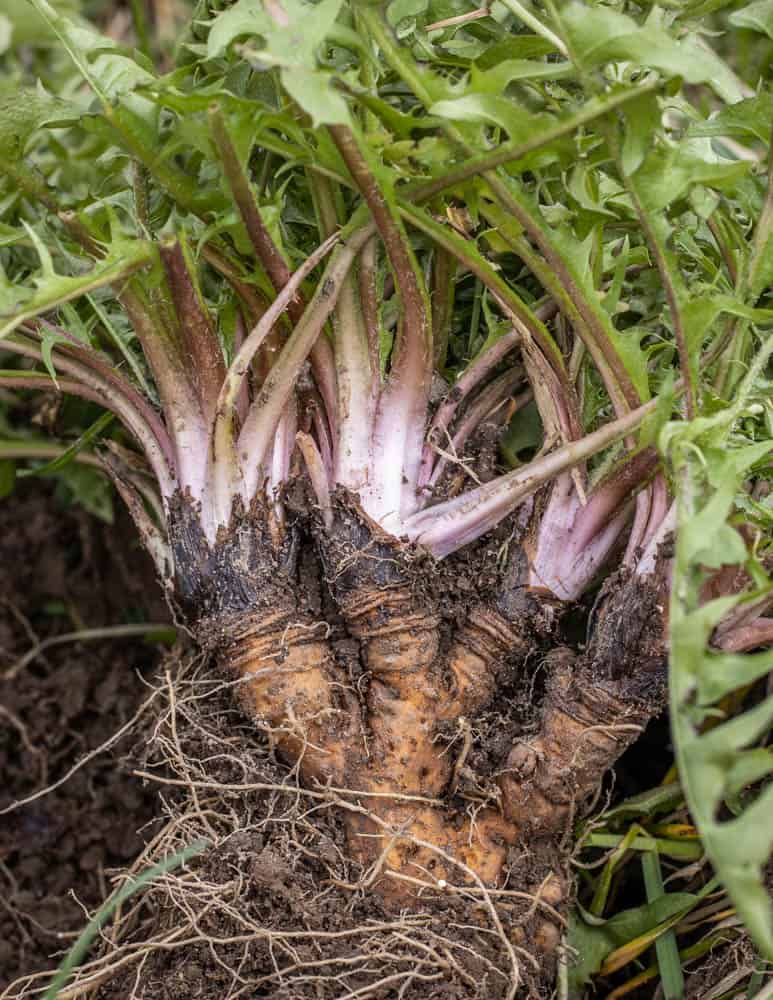
I'm pretty sure I spooked her a bit, and, there was a language barrier (she looked Hmong or Lao to me, but I can't be certain).
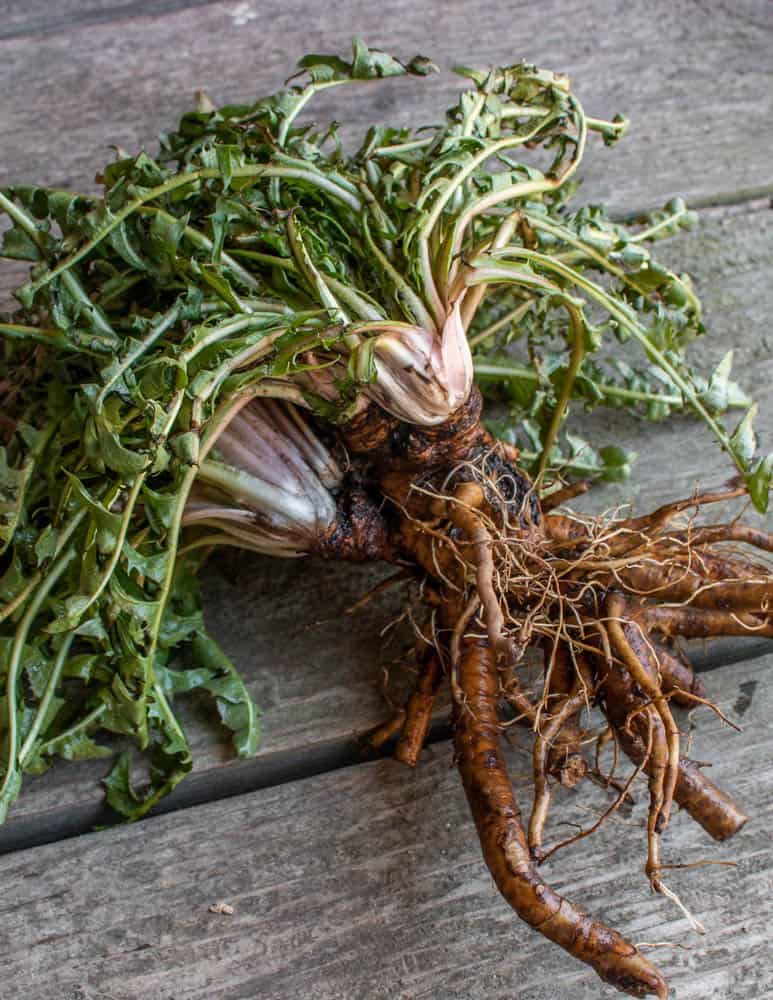
I did my best to gesticulate and inquire, but I remember her leaving pretty fast. In hindsight, if I was her, approached by some random white guy who, as far as I knew would probably poo-poo my digging up dandelions in a public park, I would have bolted too.
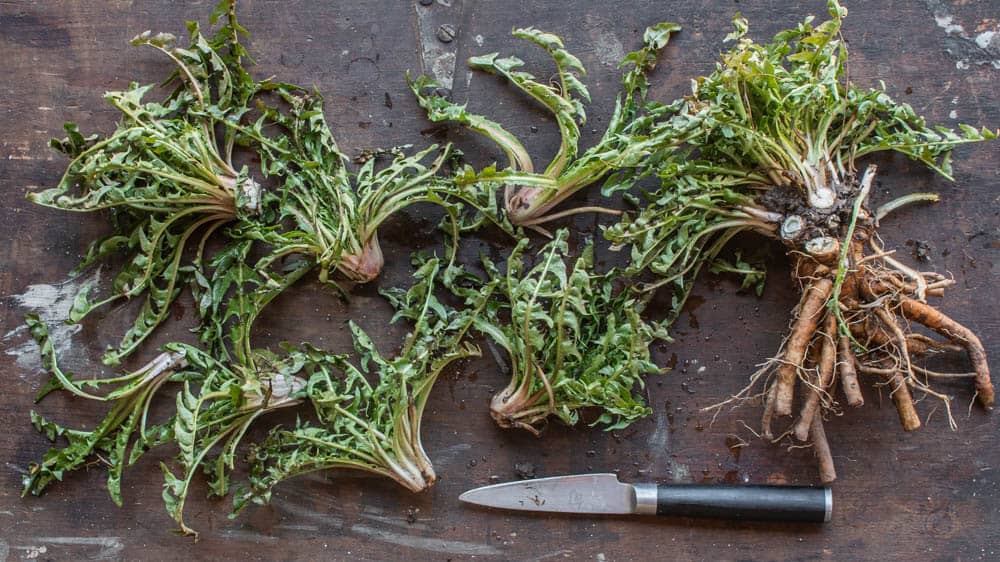
I didn't realize what she was actually harvesting until years later when I started cooking with whole young spinach attached to it's stem from my favorite farmer from Oregon, a great guy named George Weppler who used to supply Alice Waters in the early years of Chez Panisse.
The woman at the parking lot wasn't just foraging some dandelion greens, she was harvesting dandelion hearts (also known as crowns) and there's a big difference.
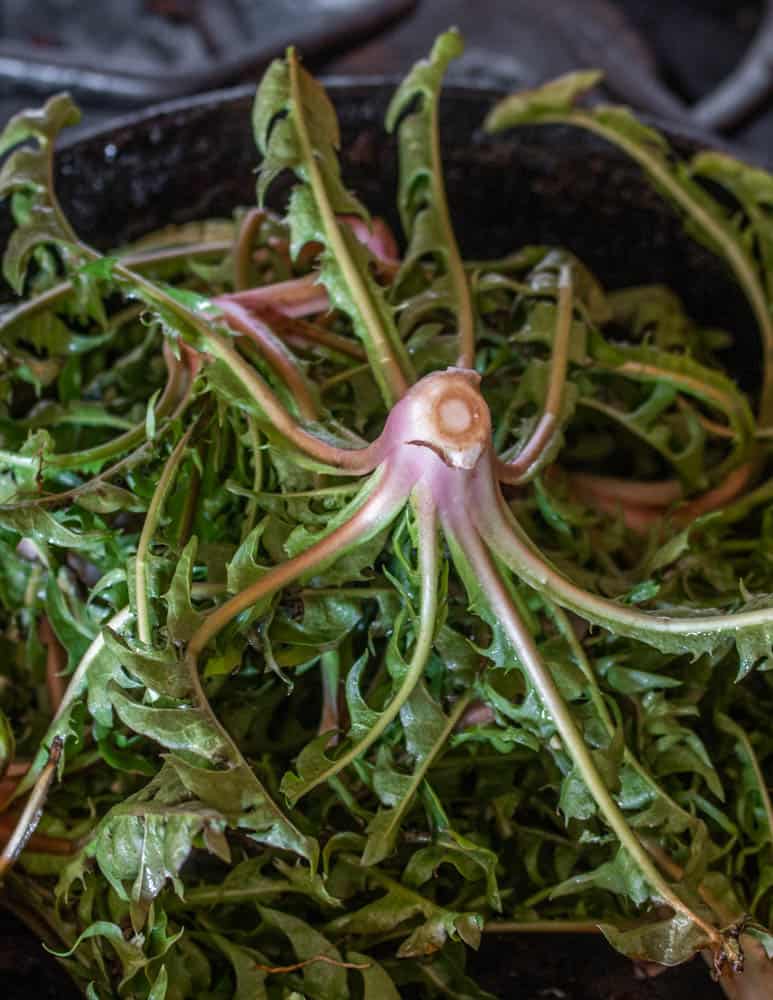
Harvest in the Spring
Dandelions are at their peak when they're young in the spring. The young rosettes are a far cry from the stronger flavor they'll develop during the growing season.
Dandelion hearts though, are the finest part I've eaten. Cooking the crowns takes a bit of work, but if you can clean a leek, potato, or carrot from a garden, you can enjoy a fantastic little vegetable any chef I know would kill to get their hands on.
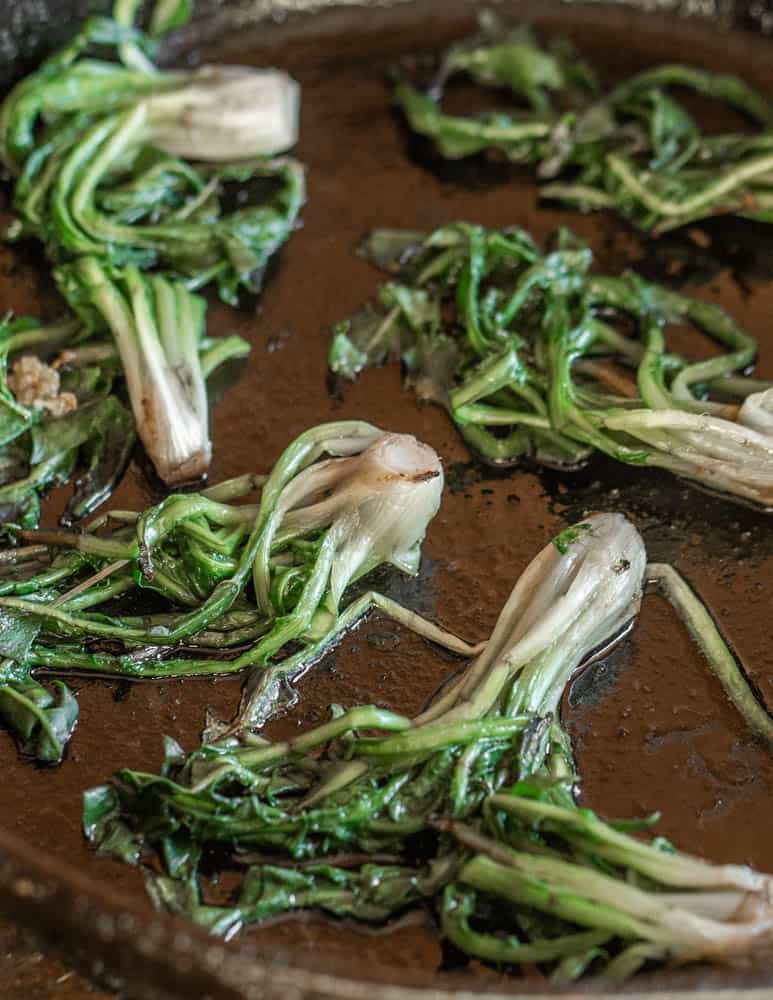
I'd forgotten about the hearts until last year when I dug up the roots to try making tinctures, and, when I levered the root from the ground with that satisfying snap only a big spade can give, staring me in the face, was a bunch of fat, juicy, dandy-crowns.
I forgot about the roots and cooked a few crowns up. They were great. The leaves on the top of the plant are just long enough to twirl with a fork, and the small, tender bottom portion with it's little bit of stem has a texture that's really good. The best comparison I can think of being tiny artichoke bottoms, with a stronger flavor.
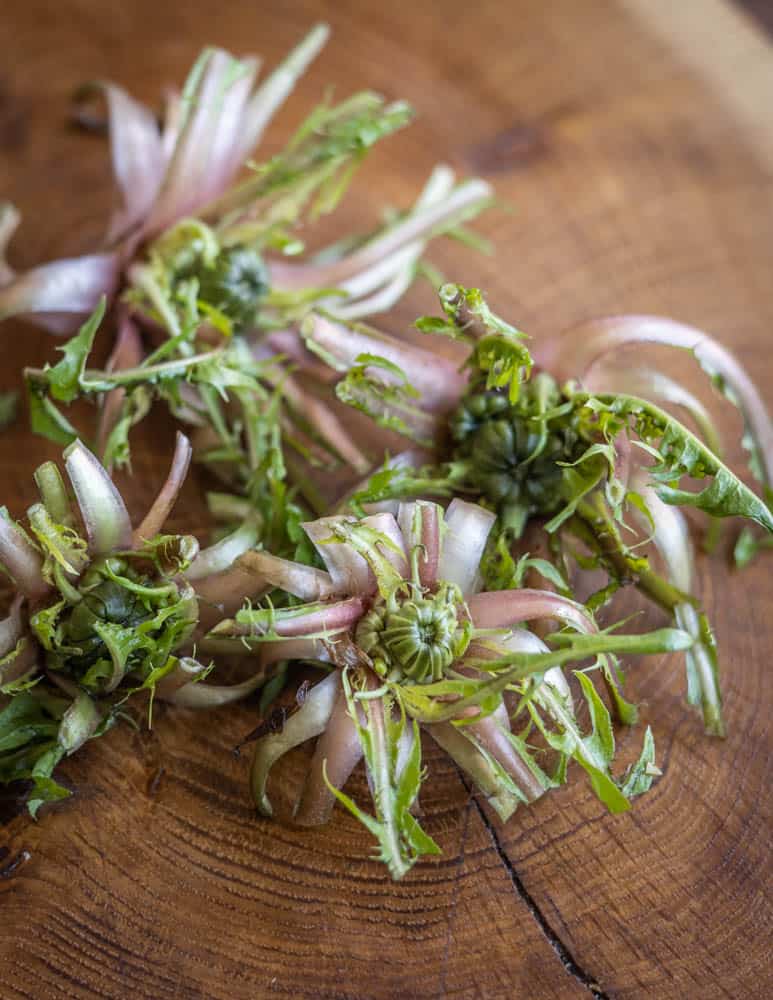
Over the course of the 2020 winter, I ran into a recipe, for dandelion crowns, in a Turkish book I've been cooking through. The recipe called for dandelions, but it instructed the cook to discard the top portion of the leaves and use the stem.
Cooked whole, with their leaves, dandelion hearts are still novel and fun, but, after a haircut (save the trimmed greens for making Lebanese Dandelions with Caramelized Onions (Hindbeh) they're transformed into a different culinary ingredient entirely that looks, at least to me, a bit like fairy fennel bulbs. Here's a few tips on harvesting and working with them
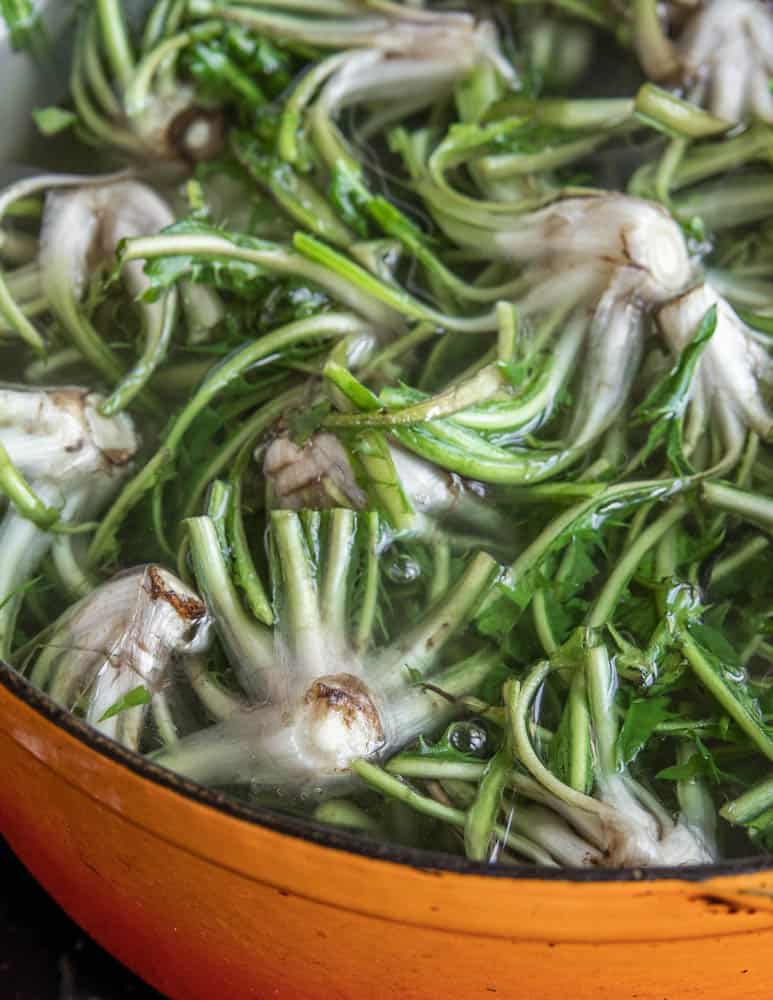
Chefs Tips
Know the terrain
The woman I met was digging around near parking lot with rocky soil-exactly the opposite of where you will find the champion dandelions you want, which will have the biggest hearts. You want rich, healthy soil that's soft and easy to dig in, if you dig after a rain they'll come up even easier.
Wild places, like open areas with sun on the edges of the woods will be good, and on the peripheries of farms that grow crops you'd like to eat. Choose the beefiest looking dandelion rosettes you can find, as those will have the biggest crowns with the largest proportion of that tender, delicious stem.
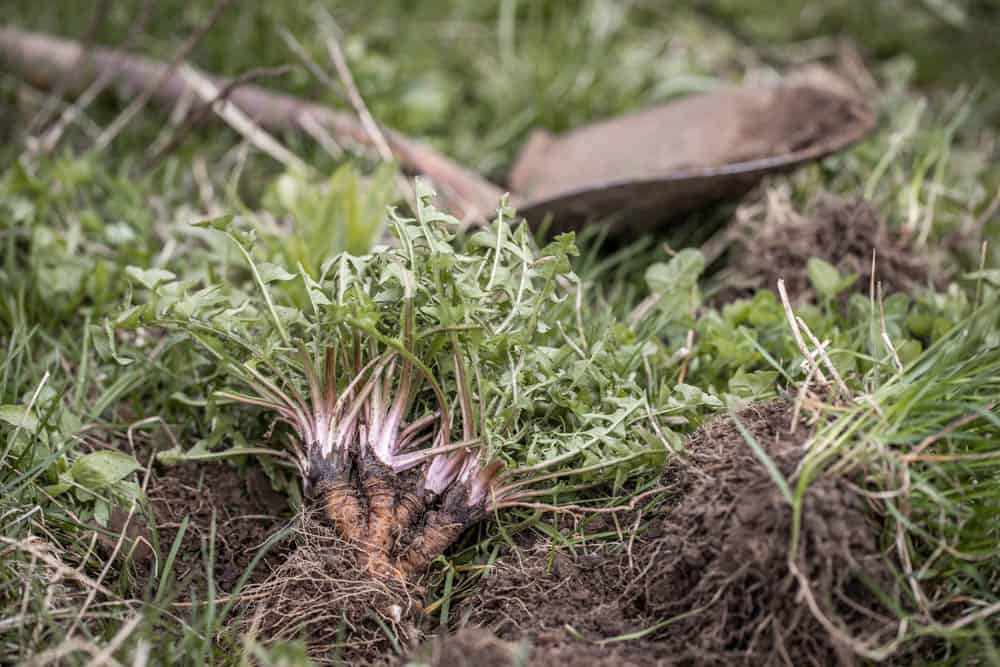
Cleaning
Dandelion crowns are dirty. My suggestion is to wash them, then wash them again, finally, to cook them, blanch them in salted water, then transfer to a bowl of warm water (cold temperatures are less conducive to loosening grit) swish them, and finally dry on towels before cooking, which is probably better described as reheating.
Only young plants will do
You must harvest the dandelion crowns when they're young, and that means when the leaves are about 6-7 inches long. Any older and the stems will be tough.
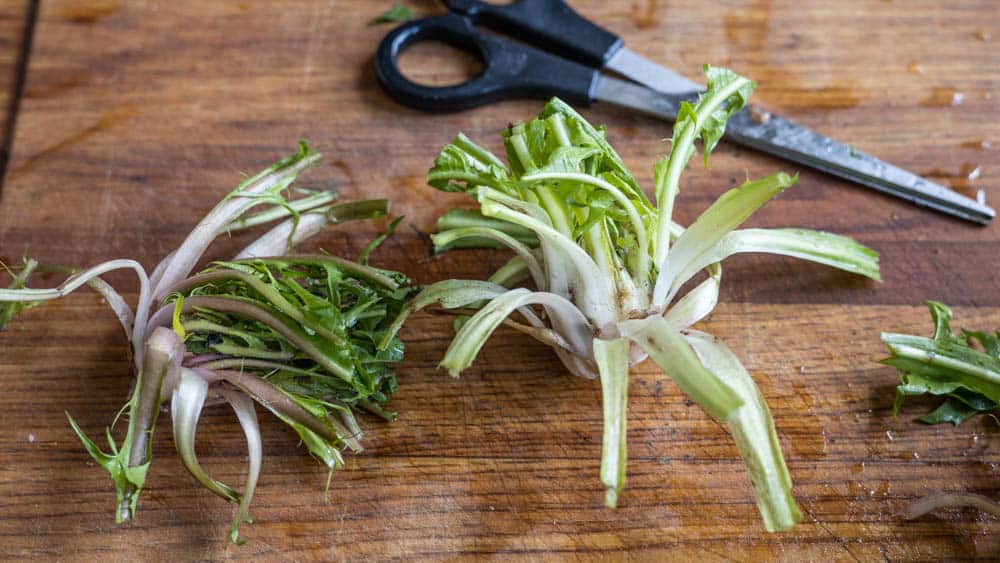
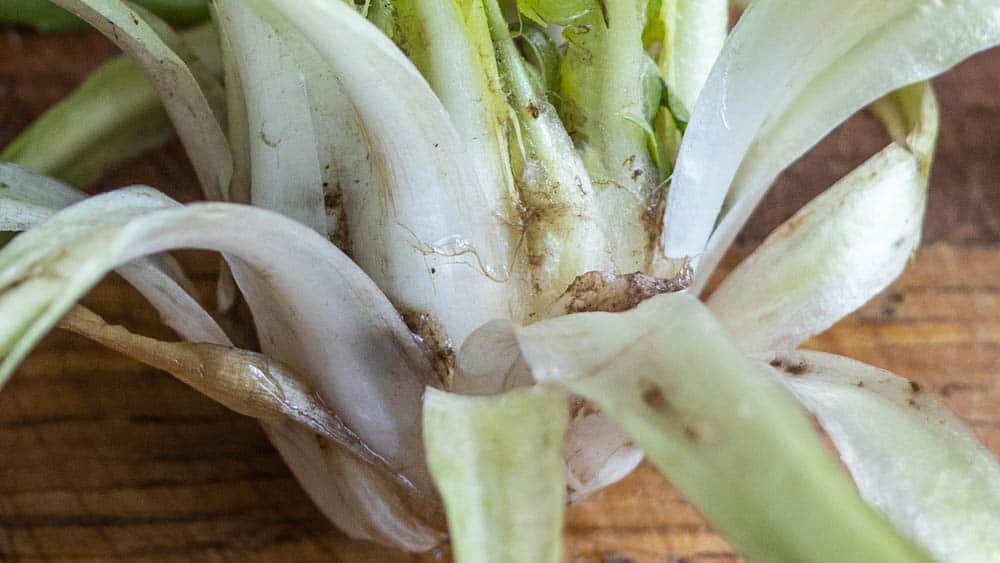
The dandelion recipe here is based around a traditional Apulian dish of wild chicory served with a puree of fava beans known in the region as Foje M'bische-a golden nugget I dug out of a book I've been translating not available in English.
In the recipe and video here, I serve it with a puree of chickpeas colored with Sam Thayer's water oak acorn oil. Traditionally the dish is made with dried fava beans.
If you can't find those (try an Asian market) mashed up chickpeas or white beans, or just some hummus will give you the idea. The combination of creamy and bitter/aster flavor is very nice. Some people add croutons fried in butter.
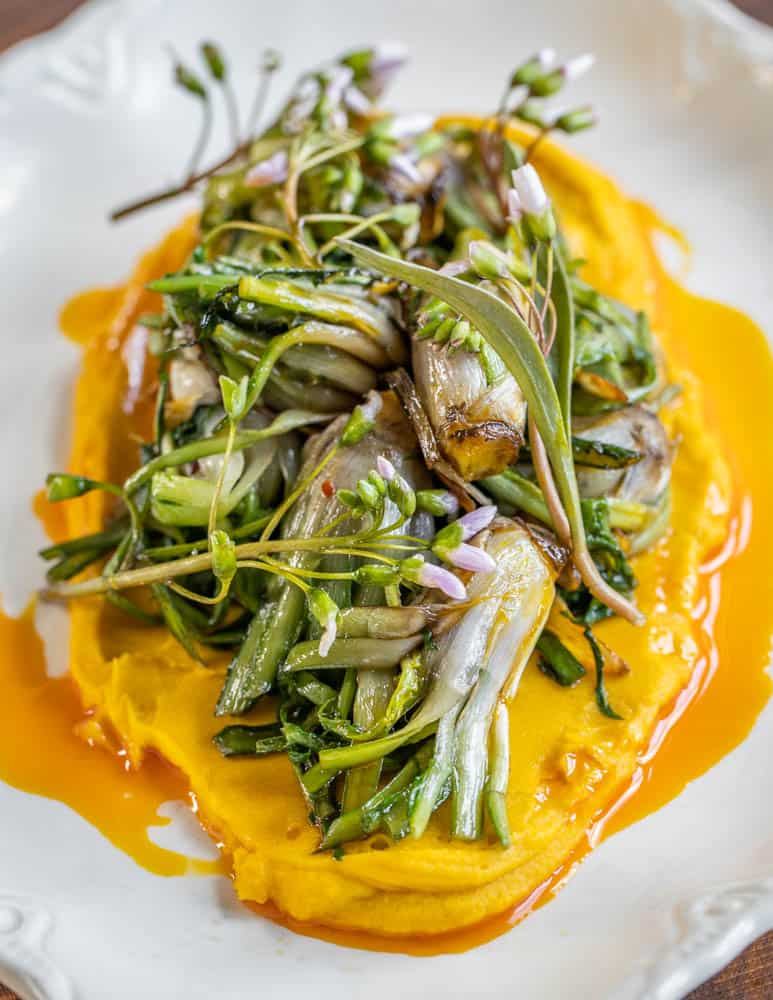
Pugliese Inspired Dandelion Hearts
Equipment
- 1 4 quart pasta pot for blanching
- 1 10 inch saute pan for finishing the crowns
Ingredients
Dandelion Hearts
- 8 oz trimmed and cleaned dandelion hearts / crowns
- 1.5 tablespoons flavorless oil or a blend of EVOO and cooking oil
- Good pinch of crushed red pepper flakes to taste
- ½ teaspoon anchovy paste
- 1 large clove garlic
- ⅓ cup bean puree traditionally more puree is served, but I opted for a cleaner presentation here
- Kosher salt and fresh ground black pepper to taste
- Wild flowers to garnish, optional I had a few sprigs of spring beauty
Bean Puree
- 1 15.5 oz can of chickpeas
- 3 Tablespoons acorn oil or EVOO
- 1 large clove garlic crushed with the back of a knife
- Juice of half a large lemon roughly 2 tablespoons
- Kosher salt to taste
Instructions
Lazy bean puree
- For the bean puree, pour the can of chickpeas with all their juice into a small pot and bring to a boil. Pour the hot beans and all of their juice into a highspeed blender like a vitamix or a food processor, along with the lemon juice, garlic and a pinch of salt.
- If you are using a small capacity blender, make sure there’s a vent as trapped steam from the hot beans could make the lid blow off of the machine, or let the beans cool a bit before blending.
- Blend the mixture, drizzling in the oil to make a smooth puree. If you have a vitamix, use the accelerator tool to help here. If you use a food processor, it may be difficult to get the puree as smooth as I have pictured, but it will still taste good.
Dandelions
- Wash the dandelion hearts and trim them, snipping off the top couple inches of leaves which you’ll save for another purpose.
- Bring a pot of water to a boil and season it with salt (roughly 1 tablespoon per quart). Blanch the dandelion hearts for a minute or two, then remove to a bowl of water (not ice water) and swish them around as a final defense against dirt. Remove the dandelion hearts to a towel to weep excess water.
- Meanwhile, heat the garlic in the oil in a cold pan on medium heat, stirring occasionally until the garlic is nearly golden brown. Add the anchovy paste and stir, then add the chili flakes if using. Quickly add the dandelion crowns, stirring to halt the cooking of the garlic. Stir the crowns well to distribute the flavors.
Serving
- When the crowns are heated through, check the seasoning by tasting one, adjust as needed for salt.
- Spread ⅓ cup of the bean puree (or as much as you like) on a plate and spread it out with an off-set spatula. Arrange the dandelion hearts on the top, drizzle with a little oil to finish, garnish with the wildflowers, and serve. Some variations of the dish add croutons fried in oil for texture.

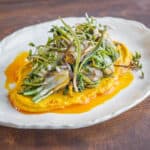
Scott P.
Alan,
While I love arugula, I've always found dandelion greens to be a bit overpoweringly bitter (maybe they weren't early enough, or prepared properly?)
But I have never tried the hearts/crowns. The recipe looks delicious - will have to give it a try.
Looking forward to getting a copy of your new book as well!
Alan Bergo
Thanks Scott. The crowns are more mild than the leaves, especially when young. Pre-orders of the book are pretty important in ensuring I can negotiate the details of the second book to make it the tome of a reference I'm envisioning. If you haven't pre-ordered I'd really appreciate it. I have the updated options HERE Alan
ViolaBlue
Watching the vid, as you plated the final dish, my salivary glands went in overdrive! Spectacular
Jerilea
I made this this afternoon. Most of the way thru I found I didn't have anchovies. This was my first journey into dandelions....aside from dandelion jelly. I would totally make this again. Sam Thayer's shop Foragers Harvest is down the road from me so I will try it with acorn oil next time. Thanks for the recipe...i have enough for tomorrow at work too.
Lindy van der Meulen
Hallo Alan, I am a follower of your site but and I want to say that you have my attention hook, line and sinker with this article. In the past I have made dandelion root tincture. I appreciate the amazing yellowness and mathematical complexity of the beautiful yellow flowers. We have them growing all over our garden and meadow we realise how vital they are for our bees but also for other pollinating insects. I alternate dandelion leaves with nettle leaves for mixing into the meat we feed our collies, I'm sure they are healthier for them. I will harvest a few of these dandelion hearts and see what we think in our household when presented on our dinner table. I will opt for your book too and the Turkish one. Thank you for your sharing and caring God Bless.
Alan Bergo
Thanks Lindy.
Nathan
Great video.
renee
Plan on going do find young nettles, will now pick some dandelion crowns, also. I dry the roots for tea, and I just
started some dandelion wine, never done this before, seems like 2021 will be the year of the dandelion. By the
way, dandelions were brought into the US by Portugese immigrants, who planted them as food source, since
they are the first plants to come up after winter, so they are not native, Thanks for the great video, loved it.
David Cole
Love the video!
Sylvie
The dish presentation is just sumptuous - the colors pop at you! It's vibrant and really makes me want to dig in there ... making sure there is plenty of rustic crusty bread at the ready. I very much like the video too - it's such a direct way to convey lots of information (how and how much to trim the crowns too). They are very well done and attractive.
Looks like you are harvesting the crowns before they bloom - correct? the mention of unopened flower buds make me think so. In which case, too bad! I missed the season here in the Northern Virginia Piedmont. I just think it's fascinating that the bluebells are blooming at the same time in our very different climates... but the dandelions are not.
Would you mind sharing the Turkish book title you are referring to... assuming it's in English (or in French). It looks really interesting.
Thank you!
Alan Bergo
Hi Sylvie, you're very welcome. Yes, I'm harvesting them well before they bloom-I prefer the flavor of them young. Here's the Turkish book, it's the best book on the region I've come across, a chef buddy turned me onto it. The Turkish Cookbook.
Karen
In Asheville, NC, I too seem to be too late. My novice attempt with our very-well-established and already-flowering dandelions was a huge disaster! But then I tried this approach with the crowns of some market radishes, and they were just wonderful.
Thank you so much for sharing this technique. I look forward to using it more on other greens and then applying it to appropriately-aged dandelions next year!
Also, thank you for the tip about the Spring Beauty garnish--wow, that's so pretty. The delicate color is just gorgeous against that spring green and rich orange puree. I had no idea you could eat these little guys!
Bonny
Can’t wait to try these. I wish I had seen this before I destroyed a hundred or more at the community garden today. But I tried the fern fronds with your recipe. Delish. Why did I wait so long to try them?
Alan Bergo
Thanks Bonnie. You'll love them.
Elizabeth
I leave my backyard in a meadow condition. I love seeing all my wild greens flourishing. Dandelions stand proudly up with their buttery hue. I smile when I see their fluffy white tops. Food from God abounds back there. I just love your writings & how you express yourself. Have a blessed day.
Alan Bergo
Cheers to a natural lawn! Good on ya.
MARIE FORBES
I HAVE FORAGED FOR MUSHROOMS AND WILD ASPARAGUS SINCE I WAS A CHILD WITH MY DAD, GERALDO ANTONIO FARINELLI, NOW BELONG TO THE BMC AND AM THANKFUL TO THE CLUB THAT I CAN ENJOY YOUR AMAZING WEBSITE! WE PICKED DANDLIONS AND ATE THEM AS A SALAD-ESPECIALLY WHEN THERE WERE SMALL FLOWER BUDS. SIMPLY DRESSED WITH EVOO, RED WINE VINEGAR AND A BIT OF SALT. PERFECTION! AND, WHEN YOU THINK ABOUT IT, THE NUTRITION VALUE IS CRAZY WONDERFUL! NICE BITE OF A GOOD SOURDOUGH BREAD WOULD ADD TO THE PERFECTION. THANKS SO MUCH!
Alan Bergo
THANK YOU MARIE!
Dorothy Bacon
More videos! I’ve always just used the dandy fellows in traditional German wilted lettuce with bacon hot dressing but am eager to have a go at this. Thanks much as always
Alan Bergo
Thanks Dotty. See you soon.
Karen Kelly
great post and video, thanks.
Alan Bergo
Thanks Karen.
Val Rossman
Beautiful and timely. Raining today but on my list tomorrow to dig some crowns. t. A Jacques Pepin video appeared on my FB feed last night and it was a dandelion crown salad (he used anchovies as well) and that's what sent me to your website looking to see what you were doing with them, then your email showed up today. You're reading my mind. As I've said before your videos and recipes are so well done and so doable. Thanks Alan.
Alan Bergo
Thanks Val. Just talked to Melissa from FH the other day. We'll be doing the Wild Harvest Festival again this year, just FYI.
Val
Glad to hear about the festival! Loved this recipe. I had to make a couple of substitutions but it came out great. The garbanzo puree is so nice!
Dave Griggs
Alan, I thoroughly enjoy your artistry with food. Your posts have become a much anticipated part of my weekend ritual. In fact I am off to forage today. I just might give the dandy crowns a whirl....I am just wondering if you could sub out the garlic with ramp bulbs?
As far as leaving a dandelion root mass on the ground to perish, so be it. Untold millions are misspent to rid "weeds" from lawns yearly. And heaven only knows how many dandelions are consigned a fate to compost piles from gardeners weeding them out. Let's not forget that, dandelions are an invasive species, they have just become so ubiquitous on the landscape that most people don't recognize them as such.
Bravo on the video. It is always a treat to be able to see you in action.
Dave
Alan Bergo
Thanks Dave, I appreciate it.
David Griggs
I just finished eating a big pile of dandelion crowns! They are really good. Thanks for bringing this to the forefront of excellent spring cuisine. I didn't make the puree, not enough time. I omitted the anchovy paste, as I didn't have any on hand, but subbed in miso paste. And then, I had a bunch of fresh ramp bulbs I used instead of garlic.
Thanks again for bringing us this springtime gem.
Dave
Oh, and I "weeded" them out of my garden, the roots and leaves to enrich the soil on a future date, as they are currently residing on top of the compost pile.
I know what I am having for lunch tomorrow.
Alan Bergo
Thanks David, yes I've been really pleased people have liked these so much. Some people have complained about the labor but if you can dig a potato and clean it, dandelions are no prob, IMO.
Tracy
Love your culinary enthusiasm. It’s quite infectious. The video is beautiful. Nicely done. It’s great to have the dirt to table tutorial. Thank you.
Alan Bergo
Thanks Tracy.
Tammie
Such a timely article and recipe, thank you so much. Soon our dandies will be growing. Spring comes late here in the NW corner of Montana. Your video was wonderful.
Alan Bergo
Thanks Tammie.
Bonnie C.
One thing you don't seem to really mention here is how bitter these hearts are. I love interesting greens - even somewhat bitter ones - but always found Dandelion greens, even domestic ones, too bitter for me. Are the hearts as bitter as the greens, or do they have a less bitter profile?
Alan Bergo
I specifically mention that the hearts have a much milder flavor than the mature greens, the blanching helps too. They're quite good.
Nina
OMG!!! Gorgeous video! Never tried dandelion hearts/crowns like this. Often when drying roots I've left the crowns on because they looked so "valuable". I couldn't bear to throw them away. You've certainly upped that whole idea. Cannot wait to try this recipe. Thanks.
Alan Bergo
Thanks Nina.
Luca
Pushing the roots firmly back in the ground, with as little twisting disturbance as possible, will allow the dandelion to regroup. Otherwise, if you're not harvesting the roots, what a waste!
Alan Bergo
I don't harvest the roots, I don't care to, and I'm free to do that. Any discussion of the sustainability of dandelions, or my choice to harvest one part over another is laughable. I suppose I should tip toe around the nettles too? Oh, and I'll make sure not to disturb the garlic mustard too much. Beyond that, it's hardly ever mentioned at all that it is nothing, absolutely nothing, and completely legal to destroy a thousand native plants to build a house, or to build a gravel pit, or frac sand mine that could destroy millions of plants. But, leave some dandelion roots out of the ground and people cry in their Wheaties. Save your zeal for a place where it's appropriate.
Renee west
ahaha, great! I agree, no crying over wasted dandelions.
Alan Bergo
Thanks Renee
Carla Beaudet
Resounding agreement from these quarters. While I'm here, a question - how about chicory crowns? I recently boiled the pooky out of some chicory greens to allay the bitter (it worked but it left flavorless, mushy greens. less time gave me bitter greens) In a fit of profligate wastefulness, I composted the mushy greens, but I still have the crowns, because I'd remembered this recipe, but could not recall whether it was for dandelions or chicory. Any experience with those?
Alan Bergo
Hey Carla,
I don't have experience cooking chicory except the ones I buy from the Middle Eastern market that are very mild. Yes, I cannot stand mushy greens for the most part (going to check on the poke today though after I go to the Arboretum!) so if I can't make a green taste to my liking after blanching and seasoning + further cooking if necessary, I avoid it for the most part. One trick to try is the old Italian method I gleaned from translating a most excellent book I've been working through. You might try blanching the crowns, then allowing them to soak in room temperature water for a few hours after cooking. That method is what the Italians use when they harvest vast varieties of greens (sometimes even ones so bitter or awkward in texture I would have never imagined eating them, geranium leaves, etc).
Carla Beaudet
Thanks! I'll give that blanch and soak method a try for the crowns. If it removes the bitter, I might even gather more greens. These methods are good to know, especially if I'm going to be doing more of this. Wintercress (a.k.a. "Creasy Greens") was the big revelation this year - too bitter (for me) raw, not at all bitter after a 5 min. simmer, and still some texture left to them, and a nice, mustard-green taste. The additional step of sauteing in a quality fat really changes how I feel about well-cooked greens. I plan to go check on the poke today, too. The weather has been pretty cold, hitting the high 30s at night, so there could still be a few morels about.